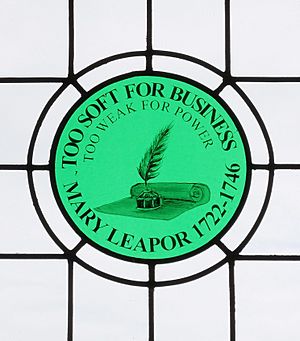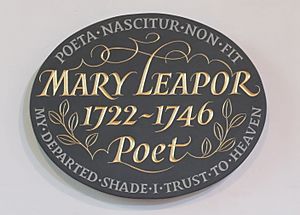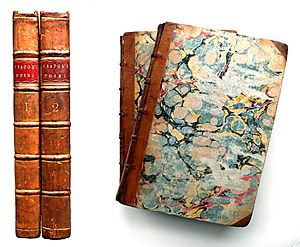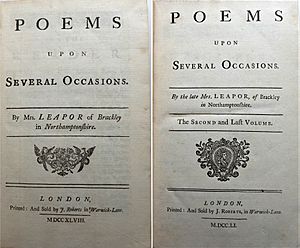Mary Leapor facts for kids
Quick facts for kids
Mary Leapor
|
|
|---|---|

Title page, Poems Upon Several Occasions (1748) by Mary Leapor
|
|
| Born | 26 February 1722 Marston St Lawrence, Northamptonshire, England |
| Died | 12 November 1746 Brackley, Northamptonshire, England |
| Occupation | Poet |
Mary Leapor (1722–1746) was an English poet. She was born in Marston St. Lawrence, Northamptonshire. Mary was the only child of Anne Sharman and Philip Leapor, who was a gardener. She was one of the few writers from a working-class background during her time. Her poems were very well-liked.
Mary Leapor's Life Story
Mary taught herself some things. She likely went to a small local school or a free school in Brackley. Her father said she started writing "tolerably" (pretty well) when she was just 10 years old. He remembered, "She would often be scribbling, and sometimes in Rhyme." But her mother wanted her to find "more profitable employment" instead of writing.
Mary was lucky to get a job as a kitchen maid for Susanna Jennens. Susanna encouraged Mary's writing and let her use her library. Susanna Jennens was also a poet and knew other famous women writers like Mary Astell and Mary Wortley Montagu.
Not all of Mary's bosses were so understanding. She lost a later job because she kept writing, even while working in the kitchen!
Mary went back home to Brackley in 1744 or 1745. She needed to care for her father, who was now a widower. Even though she had many duties and wasn't very healthy, she kept writing. Her poems became known around town.
Because of her writing, she met Bridget Freemantle. Bridget was the daughter of a former church leader. She became Mary's good friend and helped her a lot. This friendship changed things for Mary. She wrote most of her poems in a very short time after meeting Bridget.
Bridget Freemantle suggested that Mary publish a book of her poems. People would pay in advance to support the book. Mary also tried to have one of her plays, The Unhappy Father, performed in London. She had another play that she never finished. Sadly, neither of these plans worked out right away. Mary died from measles in Brackley on November 12, 1746. She was only 24 years old.
After Mary's death, Bridget Freemantle kept trying to publish her work. In 1748, she arranged for Mary's book, Poems upon Several Occasions, to be published. This was done to help Mary's father. About 600 people paid to get a copy. Three years later, a second book of her poems and plays was published. Famous writers like Mary Delany and Elizabeth Montagu supported it.
These books made Mary Leapor known as a "natural poet." This meant people thought her talent came easily. However, Mary worked hard to learn about literature. She wanted to be seen as a serious writer. When she died, she had a good collection of books. This was impressive for someone with little money.
Remembering Mary Leapor
For many years, Mary Leapor was not widely remembered. But now, people are celebrating her work.
In 2018, a special window was put in the Brackley Town Hall. It was inspired by Mary's poems. A local artist named Rachael Aldridge created the stained-glass window.
In 2019, a stone carver made a lasting memorial for Mary. It is now in St Peter's Church. The memorial includes a Latin saying: Poeta Nascitur Non Fit. This means "A Poet is born not made." It also has words from Mary's poem, "Mira's Will." In this poem, she seemed to know she would die young. The leaves on the memorial are laurel, which Mary called "the true emblem of my rhyme."
Mary Leapor's Writings
Mary Leapor often used the pen name "Mira." Many of her poems were like those of Alexander Pope, whom she admired. She also looked up to Jonathan Swift.
Mary's writing often showed her own sad feelings about life as a woman. She was described as witty, poor, and not very healthy. Her poems often talk about women and the challenges they faced. She wrote about how her gender and social class affected her desire to write poetry. Her work often challenged romantic ideas. She also stressed how important education was for women. She knew this from her own life.
Here is a part from her poem, "An Essay on Woman":
WOMAN – a pleasing but a short-lived flower,
Too soft for business and too weak for power:
A wife in bondage, or neglected maid;
Despised if ugly; if she's fair – betrayed.
In this poem, Mary Leapor describes the difficulties women faced as they got older. She strongly criticized how women were judged only by their looks. She also felt sad about the limited choices women had. Mary saw that women's lives were full of unfair situations. She wrote about these problems as injustices that needed to be spoken against. She used her own experiences as a woman to show these unfair parts of society.
Mary lived in a time when women were expected to value themselves by their beauty. Women spent a lot of money and effort to look perfect. They used special clothes and makeup to create an artificial look. Mary tried to look beyond this fake appearance. She wanted to find what she believed was true femininity.
Her poem "Dorinda at her Glass" shows this idea. It describes a woman who cared only about her looks. She becomes very sad when she loses her youthful beauty as she ages:
To her lov'd Glass repair'd the weeping Maid,
And with a Sigh address'd the alter'd Shade.
Say, what art thou, that wear'st a gloomy Form,
And Lips that with no gay Vermilion glow?
With low'ring Forehead, like a norther Storm;
Cheeks pale and hollow, as the Face of Woe,
Through this poem, Mary advises women that beauty does not last. She tells them to improve themselves on the inside.
Mary also wrote about the marriage market. This was a time when people often married for money or social status.
(From Strephon to Celia) Now, madam, as the chat goes round,
I hear you have ten thousand pound:
But that as I a trifle hold,
Give me your person, dem your gold;
Yet for your own sake 'tis secured,
I hope – your houses too insured
In this poem, a man named Strephon replies to Celia, who has told him she loves him. His answer sounds very business-like. He quickly mentions her money and property. Mary uses humor to show how women were often valued by their wealth in marriage.
Today, Mary Leapor's work is praised for its clear observations about life as a woman in the 1700s. She is still one of the few known female writers from the working class of that time.
See also
- List of 18th-century British working-class writers





